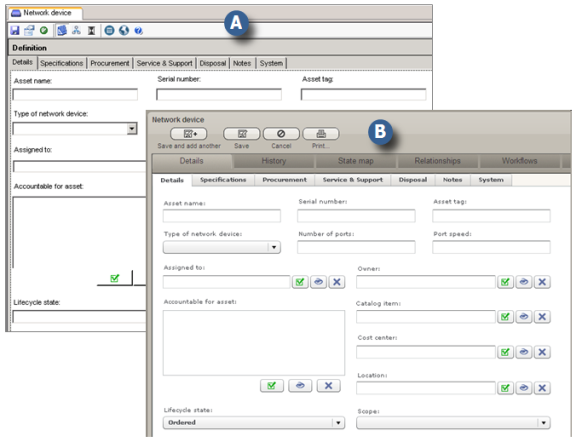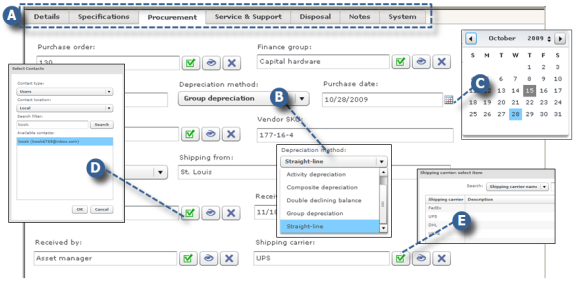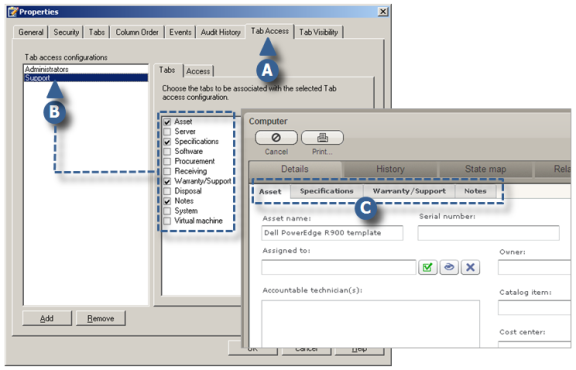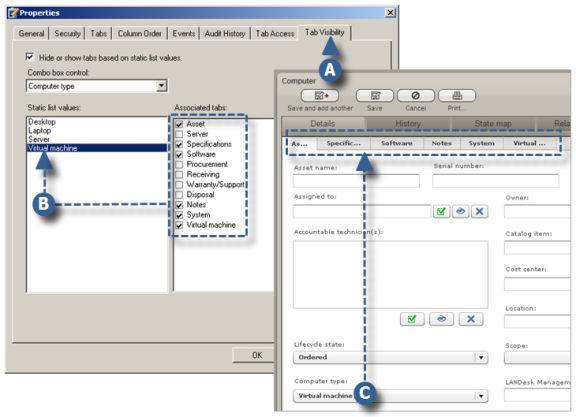
The fundamental component in Asset Lifecycle Manager, and the one upon which just about everything else depends, is the data form. The Asset Content pack includes dozens of data forms of many different types, and with a range of uses. However, all these forms fall into two groups: asset forms and supporting resources.
Asset forms are used to store, describe, and identify all relevant data related to a particular asset. For example, fields such as asset name, model, serial number, color, weight, asset tag, and many others are used to describe and identify a given asset. A "completed" asset form may have only a few of these fields filled out, or you may decide to fill them all out. At the time the form is created (using the form designer in the Design console), you can designate certain fields with attributes such as required, unique, visible, read-only, etc. You can also designate characteristics such as text fields, integers, decimals, dates, contacts, and so on, so their content can be validated and enable the system to give feedback to the user at the time they are filled out.
Supporting resource forms can include the same properties as asset forms, but these forms serve a different purpose. Supporting resource forms store, describe, and identify all relevant data for any object or element that exists or is being tracked based on its relationship to one or more assets. This includes purchase orders, approved vendor lists, manufacturers, service contracts, shipping carriers, and organizational details such as cost centers, departments, locations, management or accountability relationships, etc.
Forms are defined using the form designer in the Design console, and are displayed, populated, submitted, and the data updated using the Web console. This section gives you an introduction to examples of both asset forms and supporting resources forms, and describes their relationship and dependencies.


|
The Network device asset form, as it appears in the Form designer, in the Design console. |

|
The Network device asset form, as it appears in the Web console. |
Before beginning to populate your asset repository, it is important to understand how forms work.
On the surface, forms may appear to be simple containers for fields and corresponding data. In fact, these forms are the key connecting point for most of the data that flows between the various elements that make up Asset Lifecycle Manager. They also provide the links that enable you to create relationships between assets and many types of supporting resources. It is the structure of these data forms that enables your asset database to function as a structured asset repository.
Let's take a closer look at some of the different types of objects you can include in a form.


|
Multiple tab pages for forms with many fields. |

|
Combo boxes can be linked to static or dynamic data lists. Static data lists are used for items where the data is not expected to change regularly. Dynamic data lists are used to select current data directly from the asset repository. |

|
Date control for selecting dates. |

|
The Contact control is used to select users, roles, or groups synchronized from the Active Directory database. |

|
The Single record control lets you select items from a table that includes data collected from multiple forms. |
In addition to the objects described above, forms can also include checkboxes, links to Web pages, text areas, and numerous properties and settings that can be used to control the behavior, define the expected content, and extend the capabilities of forms. As the primary stakeholder for the asset management system, you will need to work closely with the ALM designer. In most cases, new data forms would be conceived by the Asset Manager, generally as a list of desired fields and requirements, or as a paper sketch or whiteboard drawing. This would be handed off to the ALM designer to create and configure the form using the Design console.
Detailed information for how to configure forms can be found in the ALM Designer's Guide, in "Editing forms" and "Asset form controls".
The Asset Content pack includes dozens of complete and ready-to-use data forms. These forms include asset forms, request forms, forms for identifying and linking contracts, vendors, purchase orders, cost centers, user profiles, and so forth. We recommend that you start with these forms instead of building new ones on your own. The forms and other items in the content pack have been designed to meet the needs of most organizations, with little or no further design work required.
Using the Form Properties dialog (in the Design console) an administrator can specify on a form-by-form basis, which tab pages should be visible in the Web console to different users or roles. This allows the administrator to decide which users will have access to certain information on specific asset forms. See "Tab access" in the Designer's guide.


|
In the Design console, with the form open, on the form’s toolbar, click Properties > Tab Access. |

|
The Asset, Specifications, Warranty/Support, and Notes tabs are assigned to the Support role. |

|
When a user with Support access logs in to the Web console and opens the Computer form, they only see the tabs assigned to the Support role. |
Web console users can also be given the ability to decide which tab pages they want to show (or hide) on a given form. In the example below, only the tabs related to "Virtual machine" are displayed when the user selects "Virtual machine" as the computer type. To enable this filtering capability, the ALM administrator needs to have set up the available tab page views in the Design console. See "Tab Visibility" in the Designer's guide.


|
In the Design console, with the form open, on the form’s toolbar, click Properties > Tab Visibility. |

|
The Asset, Specifications, Software, Notes, System, and Virtual machine tabs are assigned to the Virtual machine computer type. |

|
In the Web console, when the user selects Virtual machine as the Computer type, only the six selected tabs are displayed. |